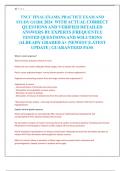Exam (elaborations)
TNCC FINAL EXAMS, PRACTICE EXAM AND STUDY GUIDE 2024 WITH ACTUAL CORRECT QUESTIONS AND VERIFIED DETAILED ANSWERS BY EXPERTS |FREQUENTLY TESTED QUESTIONS AND SOLUTIONS |ALREADY GRADED A+ |NEWEST |LATEST UPDATE | GUARANTEED PASS
- Course
- Institution
TNCC FINAL EXAMS, PRACTICE EXAM AND STUDY GUIDE 2024 WITH ACTUAL CORRECT QUESTIONS AND VERIFIED DETAILED ANSWERS BY EXPERTS |FREQUENTLY TESTED QUESTIONS AND SOLUTIONS |ALREADY GRADED A+ |NEWEST |LATEST UPDATE | GUARANTEED PASS
[Show more]



